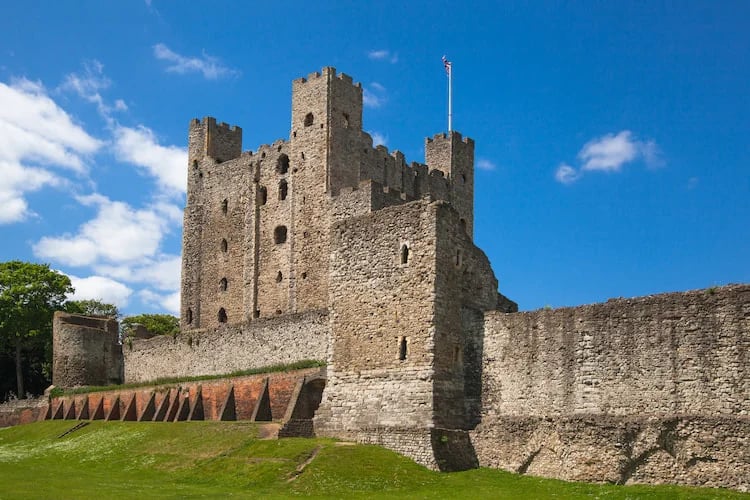The Majestic History of Rochester Castle: A Pillar of English Heritage


The Origins of Rochester Castle
Rochester Castle, an enduring symbol of English heritage, was established in the 11th century following the Norman Conquest of England in 1066. The strategic location of the castle, on the banks of the River Medway, made it an ideal defensive stronghold and a pivotal point for controlling the surrounding regions. The Normans recognized this advantage, prompting the construction of the castle as part of their broader military strategy to assert dominance over the newly acquired territory.
The castle's foundation can be attributed to Bishop Gundulf, a key figure in its early history. Appointed as the Bishop of Rochester in 1077, Gundulf was not only a spiritual leader but also a skilled architect. His expertise was crucial in the castle’s design, which included formidable defensive structures such as thick stone walls, imposing towers, and a robust keep. These architectural features were innovative for the time, reflecting the Norman emphasis on fortification and protection against potential uprisings and invasions.
As construction progressed, Rochester Castle rapidly became recognized as a significant royal fortress. Its design was a statement of power, showcasing the Normans’ architectural prowess and their intent to solidify control over the area. The castle served multiple purposes, including acting as a military stronghold, a royal residence, and a base for administrative functions. Its strategic location enabled it to serve as a gateway, controlling the main routes between London and the south-east coast of England, thus enhancing its importance in the defense against external threats.
Over time, Rochester Castle evolved into a symbol of authority and stability in the region, cementing its place in the historical narrative of England and exemplifying the architectural advancements of the Norman period.
Rochester Castle Through the Ages
Rochester Castle, standing proudly on the banks of the River Medway, has played a pivotal role in the tumultuous history of England, particularly throughout the medieval period. The castle's origins trace back to 1087 when it was constructed under the auspices of Bishop Odo of Bayeux, brother of William the Conqueror. Its design exemplified the Norman military architecture of the time, with sturdy motte-and-bailey structures that provided both defense and a formidable symbol of authority.
The castle's strategic significance was underscored during the First Barons' War (1215-1217), a pivotal conflict sparked by discontent with King John's reign. In 1215, the castle was besieged by the forces loyal to the barons, aiming to overthrow the king. The siege highlighted the castle's defensive capabilities, as it withstood months of relentless attacks. However, King John's forces eventually recaptured it, overseeing significant repair and reinforcement works that bolstered its fortifications. This event marked a shift in the castle's structure, transitioning it from a mere military outpost to a bastion of royal power and governance.
Throughout the subsequent decades, Rochester Castle continued to serve as an important symbol of authority, adapting to the changing political landscape. The castle became a nexus for local governance, often hosting royal officials and acting as a jail for local nobility. Its functions extended beyond military fortifications, embodying the evolving nature of power dynamics during the medieval era. As the centuries passed and the civil power fluctuated, Rochester Castle's architectural integrity and historical significance endured, representing the resilience of English heritage. The adaptations made to the castle over time reflect not only its pivotal role in warfare but also its enduring legacy as a local governing authority and fortification.
The Decline and Restoration of Rochester Castle
The late medieval period marked a significant decline in the prominence of Rochester Castle, traditionally recognized as an essential fortification. As military strategies evolved and the threats of invasion diminished, castles across England, including Rochester, began to lose their strategic relevance. By the 17th century, the castle faced neglect, and many structural elements fell into disrepair. The once-majestic battlements that had offered protection were left vulnerable, leading to further deterioration.
Despite this decline, the spirit of Rochester Castle endured through the centuries. The 19th century heralded a newfound interest in historical preservation, prompting initiatives aimed at restoring this emblem of English heritage. Community efforts and governmental involvement were pivotal during this period, drawing attention to the castle's rich history and its cultural significance. Various restoration plans were implemented to stabilize the structure, repair damage, and enhance the overall site for public appreciation.
Key figures in the Victorian era recognized the importance of Rochester Castle as a symbol of national history, advocating for its conservation as a valuable part of England's medieval landscape. Their efforts resulted in significant investments, leading to restoration projects that encouraged public access. The involvement of local communities further emphasized the castle's role as a heritage site, fostering engagement and education regarding its historical context.
Today, Rochester Castle serves not only as a reminder of England's martial past but also stands as a testament to the importance of preserving historical sites. As restoration efforts continue, the castle remains a focal point for understanding the complexities of medieval architecture and societal evolution. The significance of such preservation efforts underscores their relevance in contemporary society, inspiring a deeper appreciation for the shared heritage that shapes our cultural identity.
Rochester Castle Today: A Cultural Icon
Rochester Castle stands as a significant cultural icon within the landscape of English heritage. Today, it attracts numerous visitors each year, drawn not only by its historical significance but also by the array of modern initiatives aimed at enhancing the visitor experience. As one of the most well-preserved Norman castles in the United Kingdom, it offers a glimpse into medieval life and architecture, appealing to history enthusiasts, families, and tourists alike.
The castle is more than just a relic of the past; it paves the way for ongoing archaeological studies that contribute to the understanding of England's rich history. These research initiatives engage both professionals and amateur historians, fostering a renewed interest in the region's heritage. Educational programs are regularly organized, allowing visitors to partake in workshops, guided tours, and lectures that delve into the castle's storied past. Such educational experiences serve to strengthen the connection between the castle and its visitors, creating a deeper appreciation for the site.
Community engagement initiatives have also flourished around Rochester Castle, with local organizations often hosting events that celebrate the area’s culture. From historical reenactments to art exhibitions, these activities help to solidify the castle's status as a centerpiece of local identity. By embracing its historical significance, the castle instills a sense of pride among residents, who regard it as a symbol of their heritage. Furthermore, Rochester Castle plays a vital role in the tourism sector, drawing people from far and wide, thus contributing to the local economy.
In summary, Rochester Castle stands today not only as a monument of the past but as a vibrant cultural hub that continues to inspire and educate. Its presence is a testament to the enduring legacy of English heritage, fostering both a national pride and a strong local identity.








